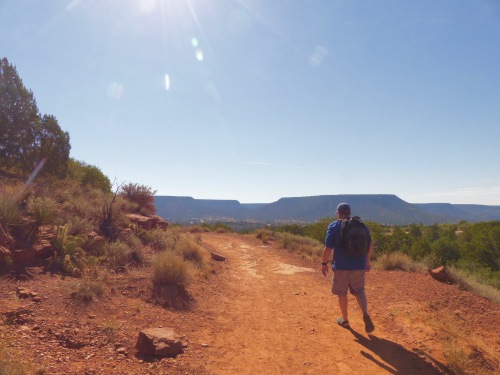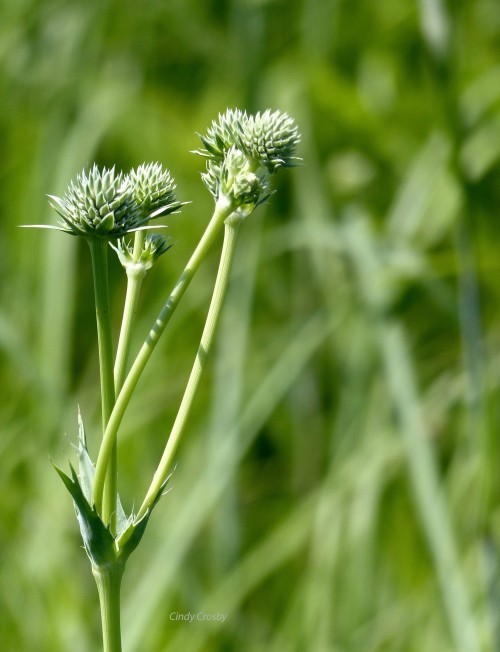“Wilderness is not a luxury, but a necessity of the human spirit, and as vital to our lives as water and good bread. ” — — Edward Abbey
******
Displacement is good for the soul; or so I tell myself as I hike the beautiful red-rock trails of Sedona with Jeff under a blazing sun.
Shade? Forget about it. Unless it’s the shade you cast as you hike.

As a prairie lover, the plants and grasses of the desert are a study in contrasts to what I know back home. I’m used to lush foliage. Vibrant wildflowers. In the Chicago region this season, the tallgrass prairie lived up to its name. Rain ensured this. Big bluestem towers over my head whenever I go for a hike; bends over trails with the weight of its tallness.

Sunflowers form jungle-like vegetation along the prairie streams. In places, vegetation is so impenetrable, I’ve had to abandon some of my dragonfly monitoring routes for the season.

But when you look closely—think out of the box a little bit—there are similarities between the prairie I know and the desert I’m hiking today that I don’t know. Here in Sedona, it’s obvious most of the grasses and plants are primed for weather extremes; small amounts of rainfall and harsh heat. There are empty creek beds everywhere that must flash flood from time to time. But today, everything is dusty and parched in the glare of the sun.

You can almost hear the plants whisper advice to each other. Conserve water. Adapt. Adapt.

The tallgrass prairies of home, while receiving around 40 inches of rainfall in a good year, are also primed for weather swings between drought and flood. As I look closely at the yucca on my hike, its foliage reminds me of the tallgrass prairie’s rattlesnake master, whose scientific name, Eryngium yuccifolium pays homage to its prickly, fleshy, yucca-like leaves. What do you think?

Both the desert and the tallgrass have fire in common. There’s a wildfire burning in a wilderness area just a few miles away. Everywhere, there is a sense of caution.

A sign on the highway notes: “Brushfire Danger High: Use Your Ashtray.” Are there still ashtrays in cars? Who knew? Burnout operations — creating small fires to stop wildfires —are underway at night. Evidently, smoke creates less of a breathing hazard for residents at night than in the daytime. Fascinating stuff. I hadn’t thought of the desert, with its cactus and forests and mountains, as a place of fire. But so it is.
A species of prickly pear cactus pops up everywhere in the desert; a relative to a prickly pear cactus we have (oddly enough) in our Midwest tallgrass prairies. Hello, friend. Nice to see a familiar face.

However, I keep a respectful distance. Those sharp bristles are nothing to trifle with.
I try to decipher the hieroglyphics of the trail as I hike. What is the desert trying to tell me?

Maybe the words of Ed Abbey again: “We need wilderness whether or not we ever set foot in it. We need a refuge even though we may not ever need to go there.”
Being in the desert prompts me to think about wilderness in new ways. Mostly, I’ve thought of wilderness as the North Woods, or maybe the Bob Marshall in Montana, or large swathes of Arctic habitat. And yet, there are ten federally designated wilderness areas in or close to Arizona’s Coconino National Forest, including where I’m hiking on the outskirts of the Munds Mountain Wilderness. Desert has its own version of a wilderness refuge, a place apart. Just as prairies are.
Another similarity between deserts and prairie is that both can be overlooked, misunderstood, and taken for granted. “Once you’ve seen the red rocks a few times, they can be pretty boring,” said the maintenance man who came to fix my hotel door lock in Sedona.

Ditto for a shopkeeper downtown. “It’s so beautiful here,” I said to her (gushingly, I’m afraid.) She shook her head. “It’s ugly!” I’ve heard much the same back home about the tallgrass prairie. “Weeds!” a friend once told me. Perhaps familiarity breeds contempt? But, as the venerable garden writer Henry Mitchell rather caustically once said, these remarks tend to come from folks who “don’t see much when they look.” And we’ve all been guilty of that, haven’t we?
So, I remind myself, Look. Look again. Don’t dismiss what you don’t understand. Find connections. Appreciate the differences. Let the desert soak in.

“What draws us into the desert is the search for something intimate in the remote.” Ed Abbey again. As an outsider here, I feel the draw. There’s so much here I don’t understand. I see a lot of other people hiking the trails, climbing the rocks, searching for something…more.
Like the base jumper, defying laws of both gravity and the legal system. As we hiked the trails one morning, we heard a yell of delight. We looked up— just as he leapt from thousands of feet high off of one of the towering red rocks and floated to the ground.

What was he looking for? Did he find it? I wonder.
I want to listen to the wisdom the desert has to offer, even when I don’t always know what I’m looking at. Or, what I’m looking for. Pay attention. Be grateful these places exist, even if this is may be the only time in my life I’ll get to see them.

I want to cherish these diverse places in my memory. Act to protect them for future generations. After all, who knows what these places may have to teach us? We need to tuck them into our hearts. We need them to be there…when we go looking.
***
Edward Abbey (1927-1989) was a writer, environmental activist, and park ranger. Although personal happiness seemed elusive (he was married five times) and he held controversial views on immigration, women, and environmental sabotage, his writings on American deserts—-leaning toward mysticism—-helped inspire a public appreciation for the desert landscape that continues today. If you haven’t read Abbey, try Desert Solitaire.
All photos and video copyright Cindy Crosby (top to bottom): Bell Rock hiking trail, Oak Creek, AZ; big bluestem (Andropogon gerardii), Fermilab Natural Areas, Batavia, IL; Maxmillian sunflowers (Helianthus maximiliani), Schulenberg Prairie, The Morton Arboretum, Lisle, IL; unknown desert grasses and plants, Bell Rock hiking trail, Oak Creek, AZ; yucca (Yucca, unknown species), Oak Creek, AZ; rattlesnake master (Eryngium yuccifolium) fire hazard sign, State Highway 169, AZ; prickly pear cactus (probably Opuntia cactaceae or Opuntia phaeacantha) and unknown grasses, Bell Rock hiking trail, Oak Creek, AZ; sand track graffiti on the Bell Rock hiking trail, Oak Creek, AZ; red rocks, Red Rock Scenic Parkway, Sedona, AZ; Bell Rock, Red Rock Scenic Parkway, Sedona, AZ; base jumper off of Courthouse Rock, Oak Creek, AZ; moonrise over Sedona on the Autumn equinox, Sedona, AZ. Any plant ID’s from my desert friends are welcome! Grateful to all of you who work to care for these amazing desert places, including Neil Chapman at TNC’s Hart Prairie in northern Arizona. Thank you.

Inspirational, as always. And your hieroglyphic is pretty cool!
LikeLiked by 1 person
Hope you are having a wonderful Autumn, Mike! Not quite as dry in Illinois as it was in Arizona, is it? Thanks so much for your continuing readership…. hope you are getting in some good prairie hikes.
LikeLike